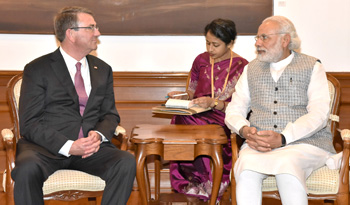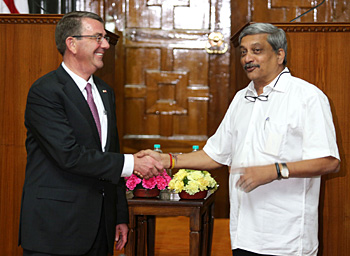INDIAN ARMED FORCES CHIEFS ON
OUR RELENTLESS AND FOCUSED PUBLISHING EFFORTS

SP Guide Publications puts forth a well compiled articulation of issues, pursuits and accomplishments of the Indian Army, over the years

I am confident that SP Guide Publications would continue to inform, inspire and influence.

My compliments to SP Guide Publications for informative and credible reportage on contemporary aerospace issues over the past six decades.
- Prime Minister witnesses 'Bharat Shakti' – a Tri-Services Firing and Manoeuvre Exercise in Pokhran, Rajasthan
- Interim Defence Budget 2024-25 — An Analysis
- Union Defence budget 2024
- Indian Army: In quest of greater firepower and policy recommendations for gaps
- Indian Army Annual Press Conference 2024
- 6G will transform military-industrial applications
Deepening partnership - India and US

Defence Secretary Dr. Ashton Carter.

Prime Minister, Narendra Modi, in New Delhi on April 12, 2016.

hands with his US counterpart Dr. Ashton Carter, in New Delhi
on April 12, 2016.

counterpart Dr. Ashton Carter at the India-US delegation level
talks, in New Delhi on April 12, 2016.
The fourth meeting on April 11, 2016 within a span of one year between the Indian Defence Minister, Manohar Parrikar and the US Secretary of Defence, Ashton Carter has resulted in an unprecedented announcement from India that both the countries have agreed in principle to sign the much discussed and negotiated Logistics Support Agreement (LSA), albeit with a different name called Logistics Exchange Memorandum of Agreement (LEMOA). This announcement has shown that something serious was cooking up between the two defence ministers of once estranged democracies during the last one year. However, the fast changing geopolitics of the Asia pacific region is encouraging the largest and oldest democracies to come closer and jointly safeguard their strategic interests in the face of increasing aggressiveness from the Chinese in South China Sea.
In fact, the US side has been pressing India to agree on three foundational agreements since the last one decade but the then UPA government did not show interest in pursuing these agreements, as these would have firmly put India as alliance partner of the US. Besides the Logistics Exchange agreement, the US side has been insisting on the early conclusion of the CISMOA (communication, interoperability and security memorandum agreement) and BECA (basic exchange and cooperation agreement), but the current Modi regime also did not allow them to be mentioned in the joint statement. However, sources in the US Embassy in New Delhi maintain that the US side will continue to insist on the finalization of the CISMOA t and the BECA for geo-spatial cooperation . The three foundational agreements will strongly bind the two nations in defence cooperation but the Indian side refrained from going that far.
However, the talks resulted in a joint statement which revealed the deepening of strategic partnership between the two countries. According to thestatement the two defence ministers reviewed the important steps taken since the signing of the new Framework for the US-India Defence Relationship last June to deepen bilateral defence ties. Carter and Parrikar also discussed the priorities for the coming year in defence ties as well as specific steps both sides will take to pursue those priorities.These included expanding collaboration under the Defence Trade and Technology Initiative (DTTI) and the 'Make in India' efforts of the Indian Government, new opportunities to deepen cooperation in maritime security and maritime domain awareness, military to military relations, knowledge partnership in the field of defence and regional and international security matters of mutual interest.
According to officials, the two countries are planning across the armed forces for greater complexity in their military engagements and exercises which include plans for more advanced maritime exercises. In fact the year 2016 will prove to be one of the most intense exchange in recent years. After a gap of many years the Indian Navy has been permitted to participate in the RIMPAC exercises where as the Indian Air Force was instructed to participate in the multilateral Red Flag exercises to be held next month.
After the talk , Parrikar said, "Our discussions spread over the past three days, have been marked by characteristic warmth, candour and a sense of mutual purpose. I am confident that the India-US relationship will be one of the key global partnerships of this century. Defence cooperation is a central pillar of India's multi-faceted relationship with the US. A stronger India-US partnership will promote peace, stability and progress in our region and the world."
Parrikar described Carter as the architect of the India US Defence Trade and Technology initiative, which has provided an unprecedented platform for the two countries to strengthen bilateral cooperation in cutting edge technologies and to address procedural delays in decision making. Both the defence ministers decided to take forward discussions under DTTI more aggressively in key areas such as Jet Engine Technology. Significant progress has already been noted in the cooperation in the framework of the joint working group on Aircraft Carriers. Both the sides also reached an understanding to conclude an Information Exchange Annex (IEA) to enhance data and information sharing specific to aircraft carriers. In support of 'Make in India' the US side shared two proposals to bolster India's suite of fighter aircraft for consideration of the Government of India. Sources privy to the talks said that US side has offered the Boeing F-18 twin engine F-18 Hornets, which can be utilised both by the Indian Air Force and the Indian Navy as the F-18s are capable of flying from the deck of an aircraft carrier also.
Both the defence ministers also agreed to expand the nature and scope of DTTI by introducing new and more ambitious projects for mutual collaboration. Interestingly the two defence ministers noted the strong complementarities between Make in India initiative and the DTTI. In this context both the defence ministers decided to personally facilitate synergies between Indian and US companies in high technology areas and in particular to promote participation of Indian companies in global supply chains. They reviewed the progress and reiterated their commitment to pursue co-development and co-production of advanced defence articles under the DTTI. In this context, the two sides agreed to initiate two new DTTI pathfinder projects on Digital Helmet Mounted Displays and the Joint Biological Tactical Detection System. They commended the on-going discussions at the Jet Engine Technology Joint Working Group (JETJWG) and the Joint Working Group on Aircraft Carrier Technology Cooperation (JWGACTC). They agreed to work towards greater cooperation in the field of cutting-edge defense technologies, including deepening consultations on aircraft carrier design and operations and jet engine technology.
In the background of Chinese aggressive behaviour in South China Sea and naval forays in the Indian Ocean region, a very significant decision was taken to set up a new bilateral maritime security dialogue to be conducted between the senior officials of the respective defence and foreign affairs ministries. In this context the decision was also announced to enhance ongoing navy to navy discussions to cover submarine related issues. Both countries will also deepen cooperation in the Maritime Domain Awareness by finalizing a White Shipping Agreement. This is relevant in the context of the concerns expressed in the joint statement regarding the current state of affairs in South China Sea . The statement reaffirmed , "the importance of safeguarding maritime security and ensuring freedom of navigation and over flight throughout the region, including in the South China Sea. They vowed their support for a rules-based order and regional security architecture conducive to peace and prosperity in Asia-Pacific and Indian Ocean, and emphasized their commitment to working together and with other nations to ensure the security and stability that have been beneficial to the Asia-Pacific for decades."
In fact, immediately after the end of Cold War in 1992 the US Pacific Commander Lt Gen Kicklighter had visited India , which resulted in the setting up of Malabar bilateral naval exercise structure, which has now seen expansion with the permanent inclusion of Japan. Now in last two and half decades, in spite of a brief suspension in defence exchanges in the aftermath of Indian Nuclear test in Pokharan in May, 1998 interaction between the two armed forces have become broad based and intense , which are now the significant aspect of India US bilateral relations. Today India has more joint exercises with the United States than any other country in the world. After a few years gap, the Indian armed forces will be taking part in multilateral exercises hosted by US forces like the RIMPAC naval exercises and the Red Flag air force exercises. According to Parrikar this deepening of engagement has necessitated the need to develop mechanisms to facilitate such exchanges, under the umbrella of Logistics Exchange memorandum of agreement , which has been agreed in principle and to be inked within a few months. The two countries have already agreed on the need to have mutually agreed memorandums to form the basis of such exchanges.





